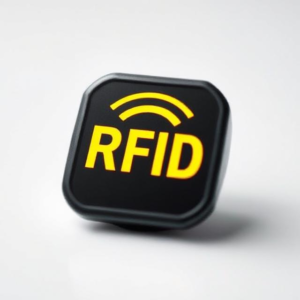What is RFID Technology?
RFID stands for Radio Frequency Identification, and it’s a technology that uses radio waves to wirelessly identify and track objects, animals, or even people. It allows information to be transmitted without physical contact or needing a line of sight.
RFID is used in many areas of our lives, even in managing inventory in warehouses.

Let’s break down how it works and why it’s useful in an easy-to-understand way.
Key Components of RFID:
- RFID Tags:
- These are small objects (also called “labels” or “chips”) that contain stored information. They can be attached to an item, animal, or even a person.
- RFID tags come in two main types:
- Passive RFID tags: These don’t have a battery. They get powered by the radio waves from the reader. Because they don’t need a power source, they’re cheaper and lighter.
- Active RFID tags: These have a battery and can transmit signals on their own, allowing them to work over a longer distance.
- RFID Reader:
- The reader sends out radio waves to communicate with RFID tags. When an RFID tag comes within range, the reader picks up the radio signals sent by the tag and then decodes the information stored in it.
- The reader can be a handheld device or a fixed one attached to a doorway or checkpoint.
- RFID Antenna:
- The antenna is a part of the reader that sends out and receives radio waves to communicate with the RFID tag. It determines the range of the RFID system.
- Backend System (Optional):
- This is where the data collected from the RFID tag is processed. It might be a database or software that tracks and manages the information, such as inventory in a warehouse or movement of items in a store.
How Does RFID Work?
The process of RFID is pretty simple:
- Tag Communication:
- The RFID reader sends out a signal (radio waves) to find the RFID tag.
- Tag Response:
- If the RFID tag is within range, it “wakes up” and responds by sending its information (like a unique ID number) back to the reader.
- Information Processing:
- The reader collects the data and passes it to a backend system (like a computer or database) that processes the information.
- The system can then use this information for various purposes, such as tracking the location of an object or updating inventory levels.
Types of RFID:
- Active RFID:
- These tags have their own power source (a battery) and can broadcast signals on their own. They have a longer range (up to 100 meters or more) and are used for high-value assets, vehicles, or large tracking systems.
- Passive RFID:
- These tags don’t have a battery. Instead, they are powered by the radio waves from the reader. Passive RFID has a shorter range (usually a few centimeters to several meters), and they are often used for product tags, ID cards, and key cards.
- Semi-Passive RFID:
- These tags also have a battery but use the radio waves from the reader to communicate. The battery helps power the tag’s chip, allowing it to work more efficiently and have a longer range than a fully passive tag, but they still rely on the reader to send out the radio waves.
Applications of RFID:
RFID is used in many real-world situations, such as:
- Retail and Inventory Management:
- RFID tags are often attached to products in stores. When a reader scans the products, it can instantly check inventory levels and track the location of items in the store or warehouse. This helps reduce the chances of items being out of stock or misplaced.
- Contactless Payment Systems:
- Many credit and debit cards, as well as payment systems like Apple Pay or Google Pay, use RFID technology. The card or device has an RFID chip that transmits payment information wirelessly when brought near a payment terminal.
- Animal Tracking:
- RFID is used in tracking pets, livestock, or even wildlife. Small RFID chips can be implanted in animals, allowing for easy identification when they pass near a reader. This is commonly used in microchipping pets to help locate lost animals.
- Access Control (Building Security):
- RFID is often used in key cards or badges for secure access to buildings or rooms. When you scan your card near a reader, it unlocks the door or grants entry to a secure area.
- Transportation and Toll Collection:
- RFID is used in toll booths on highways. Cars have RFID tags attached to their windshields, and when they pass a toll station, the RFID reader automatically scans the tag and charges the account without requiring the car to stop.
- Supply Chain and Logistics:
- In warehouses and distribution centers, RFID helps track the movement of goods, ensuring that items are shipped accurately and efficiently. It can also be used to reduce human error in inventory management.
Advantages of RFID:
- Speed and Efficiency:
- RFID allows for quick scanning of items without the need for direct line of sight or physical contact. This makes it faster than traditional barcodes, which require a scanner to directly see the code.
- Accuracy:
- Since RFID systems automatically capture data, they are less prone to human error, improving accuracy in inventory, shipments, and other processes.
- Durability:
- RFID tags can be used in tough environments. They are durable and can be read even if they are dirty, damaged, or exposed to harsh conditions.
- No Need for Line of Sight:
- Unlike barcodes, which must be scanned directly, RFID can read tags even if they are hidden inside a box, under a pile of items, or attached to an object in motion.
Disadvantages of RFID:
- Cost:
- RFID systems can be more expensive to set up compared to traditional barcode systems, especially active RFID tags or complex backend systems.
- Privacy Concerns:
- Because RFID tags can be read remotely, there are concerns about privacy and security. For example, RFID-enabled ID cards could potentially be scanned without the owner’s knowledge.
- Interference:
- Radio waves used by RFID can sometimes be affected by interference from metals or liquids, which may weaken the signal or make the system less reliable in certain conditions.
Conclusion:
RFID technology is revolutionizing the way we track and manage objects, people, and animals. It uses radio waves to communicate data between RFID tags and readers without needing physical contact or a direct line of sight. Whether it’s managing inventory in a store, providing access to secure buildings, or tracking pets, RFID has many useful applications that help make processes faster, more accurate, and more efficient.











